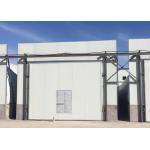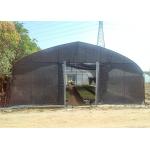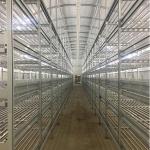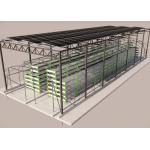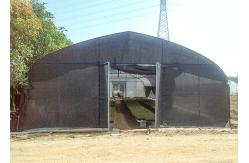Introduction of Mushroom greenhouse
Mushroom greenhouse is a kind of greenhouse used for cultivating
edible fungi(mushroom). It is covered with thermal insulation
materials and waterproof materials on the outside. Its framework is
made of hot-dip galvanized steel, and it contains mushroom
cultivation racks as well as a temperature and humidity control
system inside.
Features
I.High controllability of the environment
Temperature regulation: Mushroom cultivation greenhouses can effectively control the
internal temperature. With the use of thermal insulation materials,
heat loss can be minimized in cold weather, maintaining a
relatively warm environment. For example, in winter, some mushroom
varieties require a growth temperature between 10 - 18 °C. The
greenhouse can utilize heating equipment such as warm air blowers
and heating pipes to maintain this suitable temperature range.
Meanwhile, during hot summers, the temperature can be lowered
through ventilation systems (such as side windows, skylights,
exhaust fans, etc.) and shading facilities to avoid adverse effects
on mushroom growth caused by excessive heat.
Humidity regulation: Mushroom growth typically demands a relatively high-humidity
environment. The humidity control system equipped in the greenhouse
can precisely adjust the humidity. For instance, spray devices can
be used to increase air humidity, while dehumidification devices
can reduce it. During the mycelium growth stage of most mushroom
varieties, a relative humidity of 80% - 90% is needed, and during
the fruiting body growth stage, 85% - 95% is required, which can be
well met in the cultivation greenhouse.
Light regulation: Although mushrooms do not require as intense light as green plants
for growth, appropriate light conditions are still beneficial. The
covering materials and shading facilities of the greenhouse can
adjust the light intensity and duration. For some varieties that
need weak light stimulation to form fruiting bodies, growers can
adjust the coverage of the shading net to provide a suitable light
environment.
II.Increased yield and quality
Stable growth conditions boost growth: Since the greenhouse can provide relatively stable temperature,
humidity, light, and gas environments, mushrooms can grow under
optimal conditions. Such a stable environment reduces the
interference of adverse external factors (such as sudden
temperature changes, drought, and heavy rain), making the mushroom
growth cycle more regular and accelerating the growth rate. For
example, under suitable conditions, the growth cycle of oyster
mushrooms can be shortened, and the fruiting can be more uniform.
The yield can be 30% - 50% higher compared to open-field
cultivation.
Reduced risk of pest and disease infestation: The good sealing and protective properties of the greenhouse can
effectively block external pests and pathogens. Compared with
open-field cultivation, the probability of mushrooms being infected
by pests and diseases in the greenhouse is relatively low.
Moreover, it is more convenient to monitor and control pests and
diseases in a relatively closed environment. For example, by
installing insect-proof nets at the entrances of the greenhouse,
insects can be prevented from entering and spreading diseases. Once
signs of pests and diseases are detected, biological or physical
control methods can be adopted in a timely manner (such as
releasing predatory mites to control pests and using insect traps
to catch pests), reducing the use of chemical pesticides and thus
improving the quality of mushrooms.
III.Extended cultivation seasons
Advantages of off-season cultivation: Mushroom cultivation greenhouses break the limitations of natural
climates, enabling growers to cultivate mushrooms in
non-traditional seasons. In cold winters or hot summers, as long as
the environmental conditions inside the greenhouse are well
regulated, fresh mushrooms can be grown. For example, in the
northern winter, cold-resistant varieties such as enoki mushrooms
can be planted using the insulation facilities of the greenhouse to
meet the market demand for mushrooms during the off-season and
achieve better economic benefits.
Year-round production: By reasonably arranging the planting time of different mushroom
varieties and adjusting the greenhouse environment, growers can
achieve uninterrupted mushroom production throughout the year.
Different mushroom varieties have different requirements for
environmental conditions. Selecting suitable varieties for planting
in different seasons can fully utilize the facilities of the
greenhouse, improving the utilization rate and output efficiency of
the greenhouse.
IV.High land use efficiency
Multi-layer planting design: Multiple layers of cultivation racks can be installed inside the
greenhouse, making full use of vertical space. This multi-layer
planting method can produce more mushrooms per unit area of land.
For example, in a greenhouse with three layers of cultivation
racks, the mushroom yield can be 2 - 3 times that of single-layer
planting on flat ground. The design of the cultivation racks can be
adjusted according to the growth characteristics and management
requirements of mushroom varieties for the convenience of growers'
operation and harvesting.
Flexible layout: The shape and internal layout of the greenhouse can be flexibly
designed according to the land shape and planting plan. Whether it
is rectangular, circular, or other irregularly shaped land, a
suitable mushroom cultivation greenhouse can be built. Moreover,
growers can reasonably divide the planting areas of different
mushroom varieties according to market demand and planting
experience to achieve diversified planting and increase the
comprehensive utilization value of the land.
Components
Structural materials
Framework: It is a very wise choice to use hot-dip galvanized steel for the
framework of the mushroom shed. The hot-dip galvanizing process can
effectively prevent the steel from rusting and corroding, greatly
prolonging the service life of the framework. This type of steel
has high strength and can provide a stable supporting structure for
the entire mushroom shed, ensuring that the shed remains intact
under various weather conditions, such as strong winds and heavy
snow.
Covering materials: The covering materials have both heat preservation and waterproof
functions. Their heat preservation performance helps maintain the
suitable temperature required for mushroom growth, reducing heat
loss. Especially in the colder seasons, it can create a relatively
warm microenvironment for the mushrooms. The waterproof function
can prevent the intrusion of external moisture such as rainwater,
protecting the mushrooms from damage caused by excessive humidity
or waterlogging, like mildew.
Technical Specifications
Usage | For mushroom growing |
Width | 7 to 10 meter |
Length | Customized |
Height | 4 to 6 meter |
Frame steel pipe | 275gsm zinc coating hot dipped galvanized steel pipe |
Covering material | Black&white film + shade net |
Mushroom growing shelf | Available |
Fogging/Mistting system | Available |
FAQ:
Q: Are you a factory or a trading company?
A: We are a manufacturer with a factory covering an area of 2,000
square meters and various production equipments.
Q: What is the material of the main structure of your greenhouse?
How long can it be guaranteed to be used?
A: The main frame of our greenhouse is generally made of hot-dip
galvanized steel. This material has super corrosion resistance.
Under normal circumstances, with proper daily maintenance, its
service life can reach 15 - 20 years. It can resist common natural
disasters such as wind, rain, and snow pressure, providing a stable
growing environment for the crops in the greenhouse.
Q: Before placing a large order, we'd like to buy a sample
greenhouse to try it out first. Is that possible?
A: Yes. We can send you a small-scale greenhouse by LCL (Less than
Container Load) sea shipping.
Q: I have a piece of land and I want to grow some vegetables or
raise some fish, but I don't know what kind of greenhouse and what
size I need. Can you help me with the design?
A: Of course. You can tell us the size of your land, your expected
annual output of vegetables or fish, as well as the local climate
information. Based on these data, we can design the style, size and
price of the greenhouse for you. We'll also let you know
approximately how many workers are needed and how long it will take
to complete the installation, and how much yield you can expect in
a year.
Q: Do you provide planting technical guidance after I purchase the
greenhouse?
A: We have a professional planting technology team. After you
purchase the greenhouse, according to the crop varieties you plant,
we will customize a detailed planting plan for you, covering all
aspects such as sowing time, planting density, fertilization and
watering frequency, and key points of pest and disease prevention
and control. During the planting process, you can contact our
technicians via phone, video, etc. at any time, and they will
answer your questions promptly.
Q: How long will it take to receive the greenhouse after placing an
order?
A: Generally, for standard-specification greenhouses, production,
transportation, installation and commissioning can be completed
within 20 - 30 days after you place the order and the deposit
arrives. However, if you customize special specifications or
configurations, or the quantity you purchase is relatively large,
it may take about 40 - 60 days. We will give you an accurate time
estimate when signing the contract.
Q: What kind of assistance can you provide during the greenhouse
installation?
A: We will provide several ways to help you with the installation:
First, we'll provide written installation instructions; second,
we'll offer online installation guidance; third, we'll dispatch
engineers to your construction site for on-site installation
guidance; fourth, if there is our local agent, our agent can also
help you with the installation service.
Q: What are the quick solutions when encountering pest and disease
problems?
A: First, our technical team will help you accurately identify the
types of pests and diseases, which is the key to taking the right
countermeasures. Then, according to different pests and diseases,
we will provide corresponding biological control, physical control
or chemical control solutions. For example, for common pests like
aphids, we recommend using physical control methods such as yellow
sticky traps combined with biological control methods like
releasing ladybugs, so as to minimize the use of chemical
pesticides, which can protect the environment while effectively
controlling pests and diseases.
Q: What preparations should I make before installation?
A: First, obtain the building permit from the government if
required. Second, prepare the tools according to the tool list we
send you. Third, get the workers ready. Fourth, prepare the power
supply if needed. Fifth, prepare a place to store the goods upon
arrival to keep them from getting wet in the rain.
Q: What does your greenhouse after-sales service include?
A: We provide a one-year free warranty service. During the warranty
period, for any parts of the greenhouse with non-artificial damage
or quality problems caused by natural disasters, we will replace or
repair them for free. After one year, we still offer long-term paid
maintenance services.
